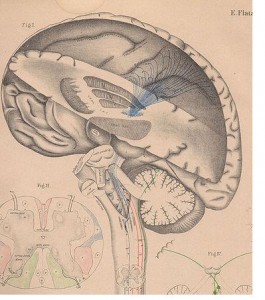SATURDAY, 30 APRIL 2011
 The 3D interactive atlas was built using data from the Magnetic Resonance Imaging (MRI) analysis of two male brains. MRI uses a powerful magnetic field to detect the nuclear magnetisation of atoms and thereby constructs a detailed image of soft tissue. Diffusion tensor imaging, which measures the diffusion of water molecules in tissue to produce neural tract images, was also used. This information was integrated with genetic data from RNA extractions.
The 3D interactive atlas was built using data from the Magnetic Resonance Imaging (MRI) analysis of two male brains. MRI uses a powerful magnetic field to detect the nuclear magnetisation of atoms and thereby constructs a detailed image of soft tissue. Diffusion tensor imaging, which measures the diffusion of water molecules in tissue to produce neural tract images, was also used. This information was integrated with genetic data from RNA extractions.The resulting map contains one thousand searchable anatomical sites and presents relevant data on gene expression and biochemistry at each site; for the two male brains used, a 94% similarity in biochemistry was found, and at least 82% of the 25,000 or so genes in the human genome were found to be expressed. In addition the atlas will allow researchers to, for example, quickly identify which areas are targeted by a specific drug.
The Allen Institute is currently mapping a female brain and aims to run at least ten brains through the system. It is hoped that the atlas will prove useful in furthering understanding of how the brain works and ultimately how to create effective drugs to combat brain diseases [1].
Written by Zoe Li
